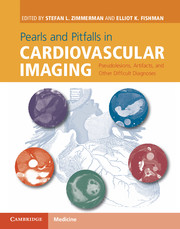 Pearls and Pitfalls in Cardiovascular Imaging
Pearls and Pitfalls in Cardiovascular Imaging from Section 4 - Coronary arteries
Published online by Cambridge University Press: 05 June 2015
Imaging description
Coronary artery aneurysms are defined as localized vessel dilatation exceeding 50% of the adjacent normal coronary artery diameter. A precise definition of the threshold between aneurysm and “giant” aneurysm is not well established, but some authors have suggested that aneurysms > 20 mm meet this criteria. Giant coronary artery aneurysms are identified by the presence of a round or ovoid structure on the epicardial surface of the heart in the typical location for coronary arteries. Often discovered incidentally on echocardiogram, they will appear as a paracardiac mass with varying degrees of flow on Doppler interrogation depending on presence of thrombus. On non-contrast CT, they are low- attenuation, rounded masses that may have peripheral calcifications related to atherosclerosis. After contrast administration, lesions will enhance similar to blood pool, although varying degrees of thrombosis may be present (Figure 38.1). Large aneurysms can erroneously appear thrombosed on cardiac CT due to incomplete filling at the time of arterial phase acquisition (Figure 38.2). Delayed venous images will demon- strate further fill-in of the aneurysm. Cardiovascular magnetic resonance (CMR) imaging will typically show low signal on dark blood images due to flow (Figure 38.1). Steady-state free precession (SSFP) and contrast injections with gadolinium will confirm high signal in the structure due to blood and may show evidence of thrombus (Figures 38.1 and 38.2).
Importance
Patients with giant coronary aneurysms may present with life-threatening tamponade due to rupture. Thrombosis, fistulization to cardiac chambers, and embolization have also been noted in the literature. Giant coronary artery aneurysms can be misinterpreted as cardiac tumors, particularly if only limited imaging is available. The distinction between tumor and aneurysm could have significant impact on treatment.
Typical clinical scenario
Coronary artery aneurysms more commonly affect males and have an incidence between 0.3% and 5%. Coronary aneurysms greater than 20 mm are extremely rare and in one series represented only 0.02% of patients undergoing cardiac surgery. They are more likely to involve the right coronary artery.
To save this book to your Kindle, first ensure no-reply@cambridge.org is added to your Approved Personal Document E-mail List under your Personal Document Settings on the Manage Your Content and Devices page of your Amazon account. Then enter the ‘name’ part of your Kindle email address below. Find out more about saving to your Kindle.
Note you can select to save to either the @free.kindle.com or @kindle.com variations. ‘@free.kindle.com’ emails are free but can only be saved to your device when it is connected to wi-fi. ‘@kindle.com’ emails can be delivered even when you are not connected to wi-fi, but note that service fees apply.
Find out more about the Kindle Personal Document Service.
To save content items to your account, please confirm that you agree to abide by our usage policies. If this is the first time you use this feature, you will be asked to authorise Cambridge Core to connect with your account. Find out more about saving content to Dropbox.
To save content items to your account, please confirm that you agree to abide by our usage policies. If this is the first time you use this feature, you will be asked to authorise Cambridge Core to connect with your account. Find out more about saving content to Google Drive.